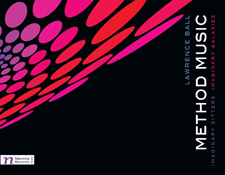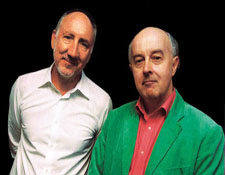It’s the time of year for saving money!

Before I can get to reviewing this two – CD set of music that involves none other than The Who’s Pete Townshend, a bit of set up is involved:
1) Set your personal way back machine to 1971 or whenever you first heard the (now) classic rock anthem “Baba O’Riley” from The Who’s seminal Who’s Next album. Remember that mesmerizing repetitive synthesizer pattern which forms the core of the song from beginning to end. Understand that the song was actually named after influential minimalist composer Terry Riley.
2) If you haven’t yet heard Terry Riley’s landmark composition In C, I strongly urge you to do so before buying this album.
3) “Baba O’Riley” — and most of the other songs on Who’s Next — was supposed to be in Townshend’s second rock opera called Lifehouse; it was aborted for numerous reasons, not the least of it being that the story line was quite advanced and confusing to all but Townshend; Lifehouse was about 40 years ahead of its time, it even raised themes that echo today’s modern Internet.
4) Townshend never gave up on Lifehouse, eventually finishing it as a radio play aired on the BBC in 1999 and continuing experiments in musical themes and theories created during its writing.
You are now somewhat caught up to the 21st Century where, around 2007 Townshend started an experiment in a sort of collective audience music experience via the internet in conjunction with noted mathematician / composer Lawrence Ball. Working together, Ball created software to bring Townshend’s conceptual ideas to life (if you will) enabling the generation of personalized, unique pieces of music based on personal data from individuals participating in the experiment. This information was collected via the Internet and then input into Ball’s software for playback and then, ultimately, editing into compositional sequences found on the album at hand, entitled Method Music. For the purposes of the album (and probably to avoid copyright issues and such) Ball created a series of “Imaginary Sitters,” data for individuals that don’t really exist. Thus the tracks bear titles such as “Sitter 09” and “Sitter 11.” The first title is called “Meher Baba Piece” which works off data based on Townshend’s spiritual guru (this plays like a variation and theme based on Townshend’s original sequence used in Baba O’Riley).
In the album’s liner notes, Mr. Ball notes: “I generated and then selected melodic streams which were then woven together on a computer with a sequencer. This a part-programming and part-editing job, but it begins with imagining and developing patterns of notes, often cascading canons with intricate phase changes.”
Got that?
So now they have all this computer music pumping out of a sequencer. What to do with it? This is where, dear audiophiles, it gets kinda interesting (as if this weren’t interesting enough). Rather than just mix the album down in the box, Townshend wanted to get some live musicality happening with the music. So they set up shop at his Oceanic Studios (in Twickenham, England) triggering wide array of musical samples being played out over 36 speakers. These performances played across the 36 speakers in the studio were then recorded to a mix you hear on disc one.
Disc two, subtitled “Imaginary Galaxies” (according to their PR firm’s website) “expands the forms into larger structures with greater permutations, variables, and variety.” These Galaxy tracks are thus made for the late Syd Barrett (of Pink Floyd), Hugh Hopper (of the original Soft Machine) and György Ligeti (an important 20th century contemporary classical music composer).
Still with me?

Good. So, how does it sound? Well, I’ll be honest, its pretty trippy (albeit beautiful) stuff. If you aren’t of the mindset for this kind of trance-inducing repetitive work, this may not be for you. That said, if you like the sound of musics by the likes of Phillip Glass, John Adams and Terry Riley, then you’ll probably want to check this out. As hardcore of a fan as I am of Townshend and Lifehouse — and I really am, I even own the box set that Townshend sold exclusively via his website — it has taken me the better part of a year to get my head around Method Music in order to be able to write about it for you. I’ve now listened to it at least four or five times under a variety of situations and I am finally in tune with it enough to (a) appreciate its inherent beauty and (b) detect the variety of sounds, and melodic threads happening there. When you first put it on, your mind may just hear a loopy sequence and (emotionally) shut down. Its sort of like how some people can’t handle Philip Glass due to the repetition; many musicians can’t even handle playing music that repetitive.
All that said, I find this a fascinating project, one that grows on me with each listen. Frankly, my only complaint is that they didn’t make a surround sound mix of the performances. With 36 speakers in the room, it would have been a natural opportunity to capture the sounds flying around the room and put it into an immersive mix that home theater enthusiasts can experience.
Its never too late. Maybe Pete has a surround mix already in the bag and is waiting for a special moment to issue it. I’ll be looking forward to that time whenever it happens.
If you want to read more on the math behind the music, visit Lawrence Ball’s website.
Order Method Music from Amazon.com.
Here is a video of Ball performing — and rendering — a piece of music using the program he created in a live setting.
Here is Ball describing the process of providing information as a “Sitter” participant in the process of making Method Music.
Mark Smotroff is a freelance writer and avid music collector who has worked for many years in marketing communications for the consumer electronics, pro audio and video games industries, serving clients including DTS, Sega, Sony, Sharp, AT&T and many others. www.smotroff.com Mark has written for EQ Magazine, Mix Magazine, Goldmine/DISCoveries Magazine, BigPictureBigSound.com, Sound+Vision Magazine and HomeTechTell.com. He is also a musician / composer who’s songs have been used in TV shows such as Smallville and Men In Trees as well as films and documentaries. Mark is currently rolling out a new musical he’s written: www.dialthemusical.com.






